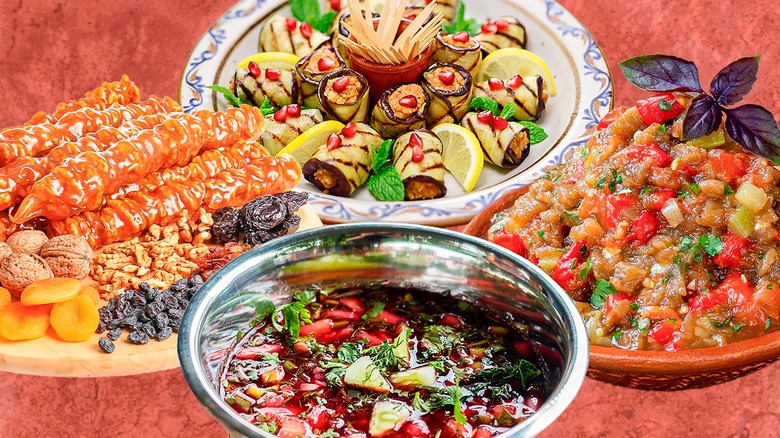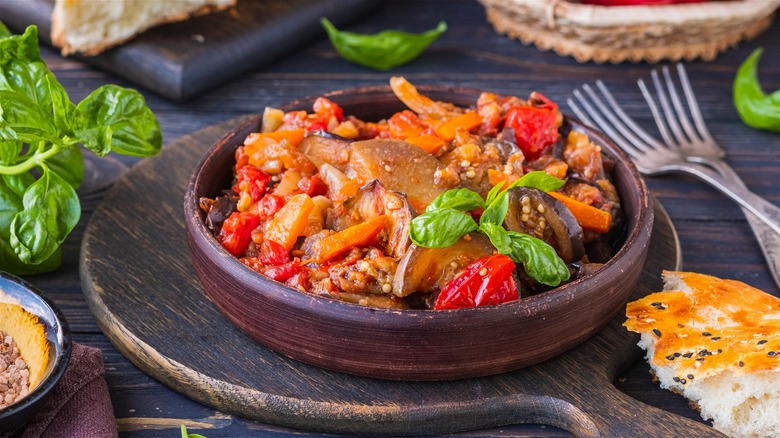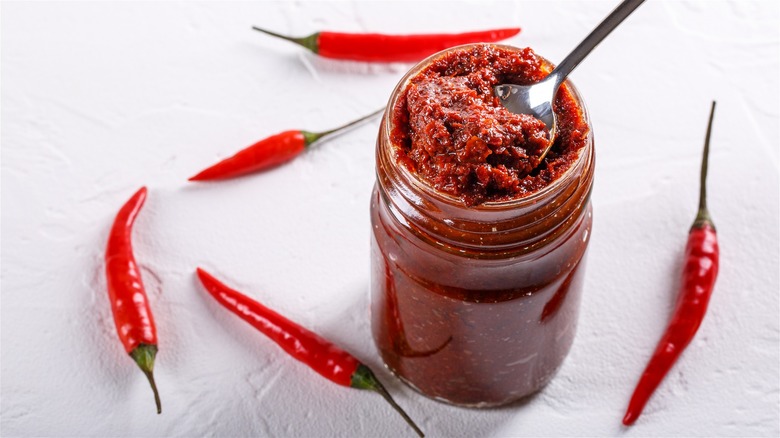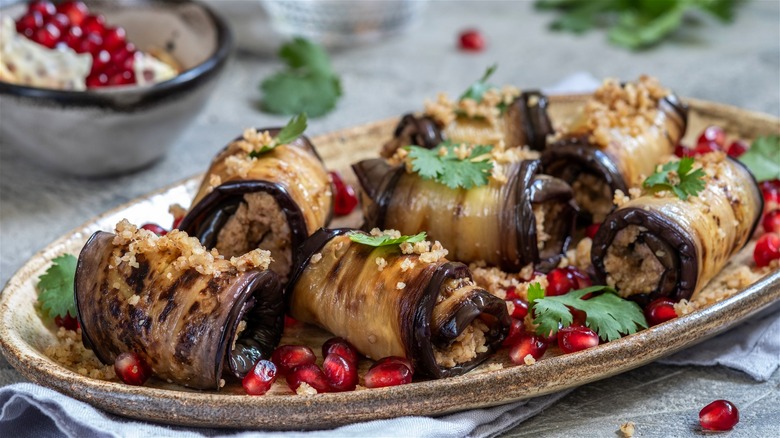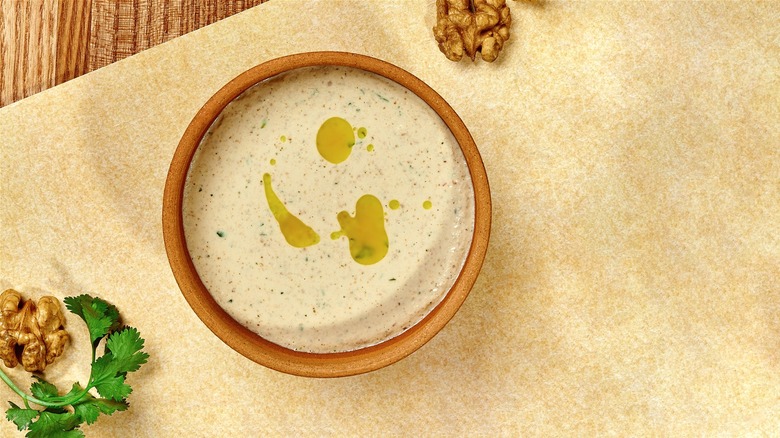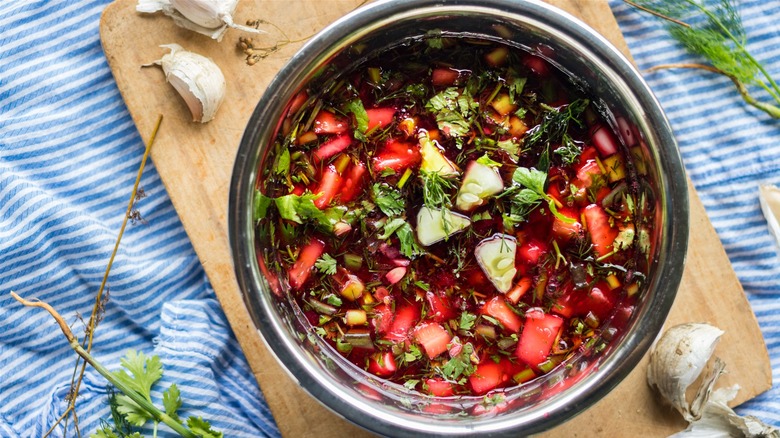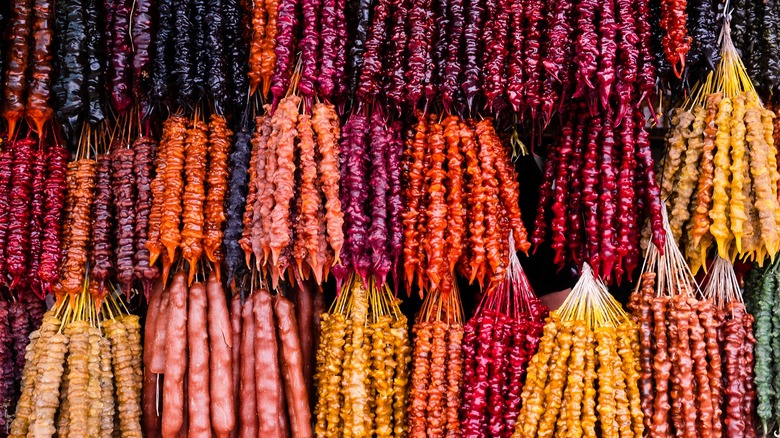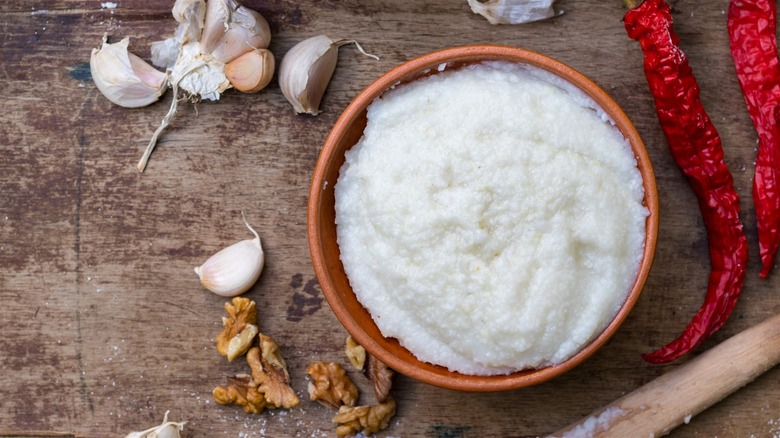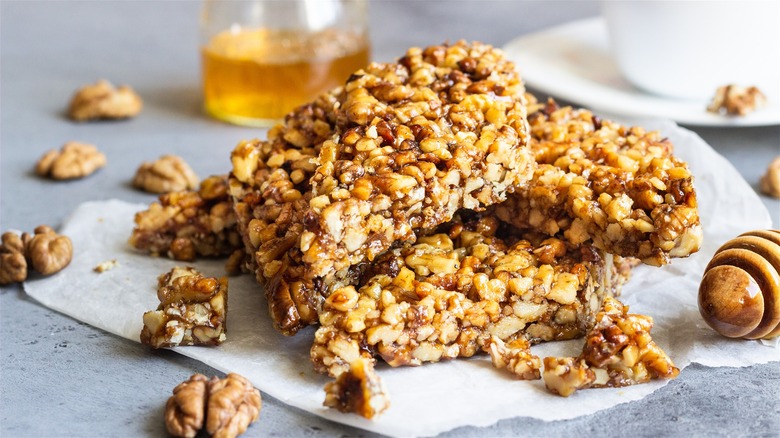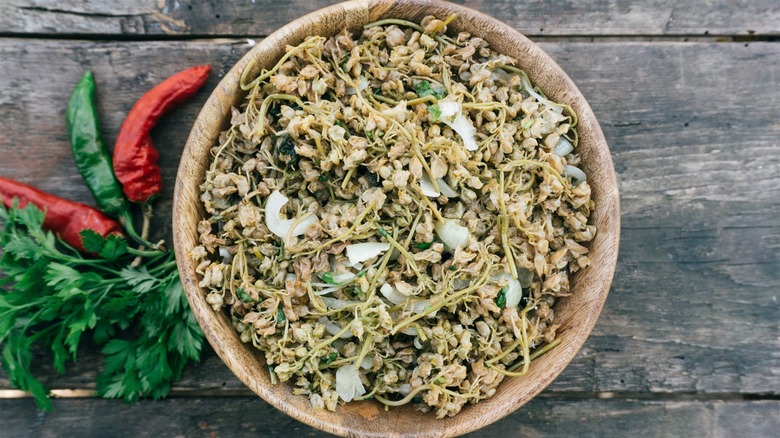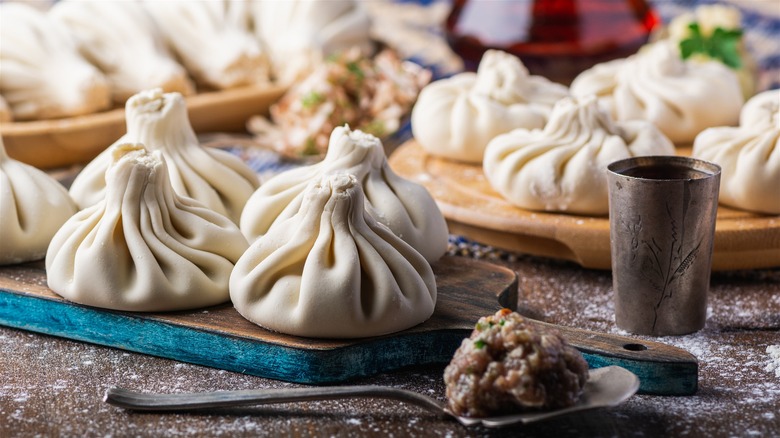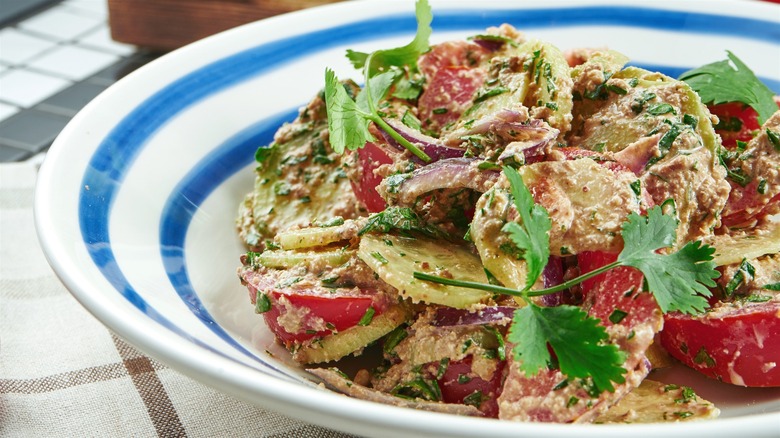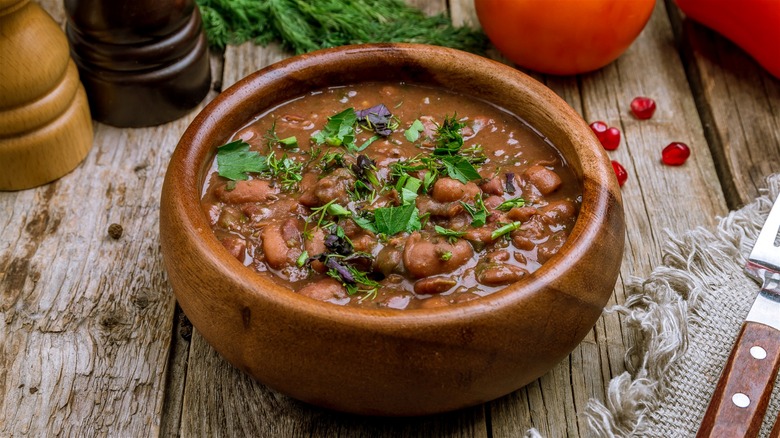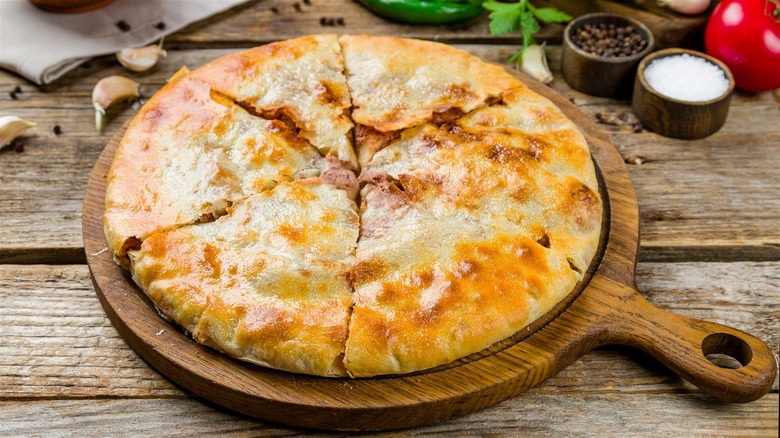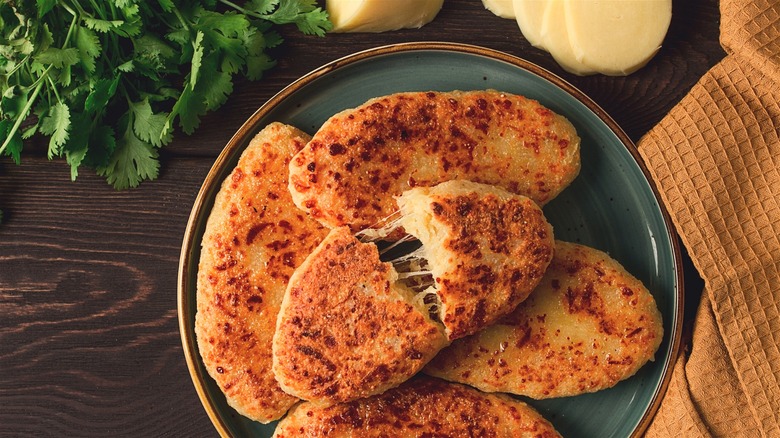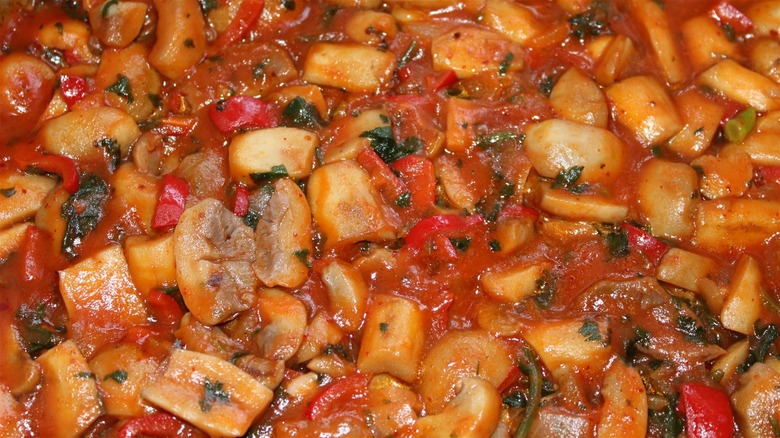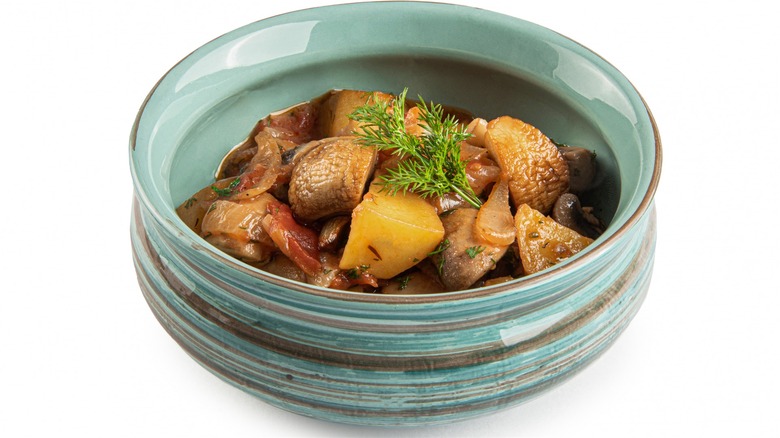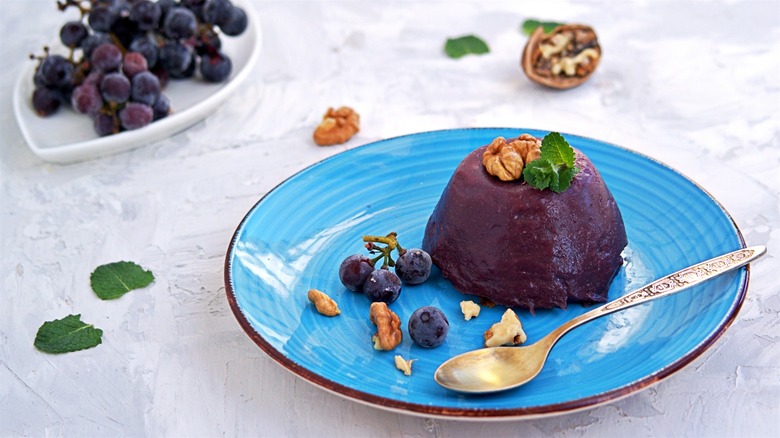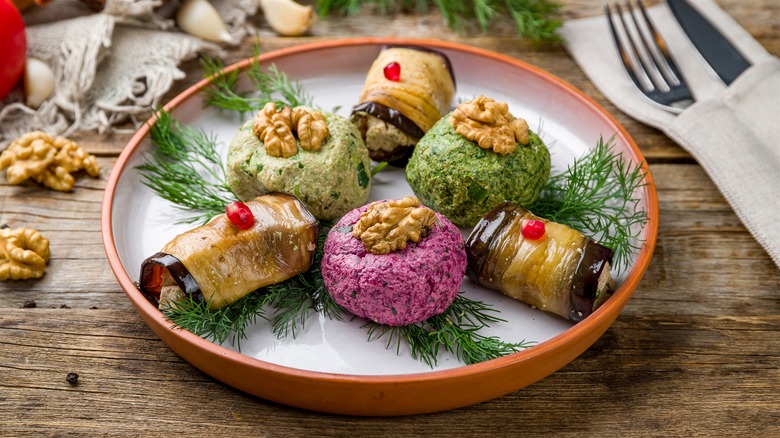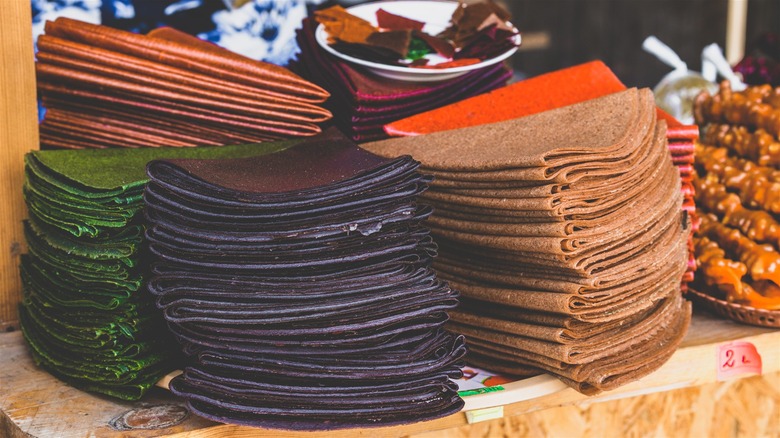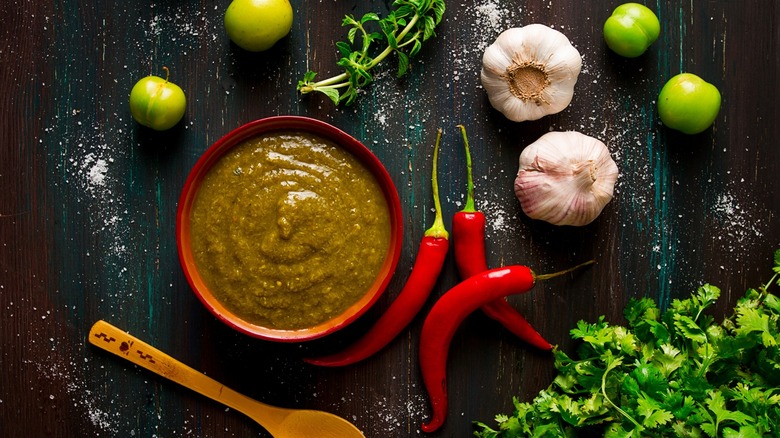20 Vegetarian Georgian Dishes That Should Be On Your Radar
Georgian cuisine, often celebrated for its decadent cheese-laden khachapuri and meat-filled khinkali, harbors a hidden, vegan-friendly secret. The country's long-established vegetarian and vegan cuisine is rooted in centuries-old Orthodox traditions. Look beyond the meat-heavy facade, and you'll discover samarkhvo or "fasting" dishes. Plant-based meals are the unsung heroes of Tbilisi's vibrant food scene, unexpectedly hailed as a destination city for vegetarians.
Georgian food is a cornucopia of naturally vegan delights, from the wholesome fruit sweets hawked in bustling street markets to the hearty bean and mushroom stews that warm the soul. But don't be fooled by the simplicity of Georgia's humble plant-based offerings. These dishes are singular gems, distinctive to the country's culinary landscape. Should your travels ever bring you to this gastronomic paradise, dare to indulge in these vegan wonders if you ever encounter them in person.
Ajapsandali
We have vegan-friendly Georgian cuisine with an unassuming yet flavorful gem known as ajapsandali (stress on the penultimate syllable). Late-summer tomatoes and eggplants play the lead roles in this ode to seasonal produce. Dubbed "Georgian ratatouille," it actually has more in common with Turkey's imam bayildi, with an ensemble of optional vegetables like bell peppers, green chilies, onions, potatoes, and carrots, adding depth to the melody.
What makes it stand out from its French and Turkish cousins is the relatively firm texture of the oven-roasted or sautéed vegetables, often sprinkled with a teasing kick from ajika and a generous smattering of cilantro. This versatile number adapts to the seasons as well: It's happy to be served as a chilled appetizer in the summer, whereas in the winter, it warms the soul as a comforting vegetable stew.
Ajika
Is it a sauce? Is it a dip? Is it a spice mix? Depends on who you ask. Trader Joe's Fans might know ajika since it's been introduced as a seasoning by the retail chain a couple of years ago. The blend consists of crushed chili peppers, coriander, and fenugreek, jazzed up with a hint of garlic, marigold, and salt. It's become the darling of American kitchens, lending a spicy, garlicky punch to anything from avocado toast to veggie pot roast.
Yet, ajika's roots run deep in the soils of Georgia, where it's not just a condiment but an indispensable facet of the country's cuisine and intangible cultural heritage. Such is the fervor for this versatile accompaniment that variations can be found nationwide. But the classic red one usually features spicy smoked red pepper, garlic, and dried spice, all crushed together into a thick paste that can be served with most Georgian dishes (and beyond).
Badrijani nigvzit
Besides tomatoes and peppers, eggplant is one of the most popular vegetables in Georgian cooking. And nowhere is it more evident than in a popular cold appetizer, badrijani nigvzit or stuffed eggplant rolls. Filled to the brim with a delectable creamy paste, they are a must-try for plant-based eaters, managing to hold their own amid the meat-heavy Georgian feasts known as supras.
This dish is typically made from Chinese eggplants, known for their slim, elongated shape, which are thinly sliced and fried in generous amounts of oil. The filling is made from walnuts (another staple ingredient in Georgian dishes) pulverized and then melded with minced garlic and fresh cilantro. The secret ingredient? The nutty, fragrant powdered blue fenugreek, known locally as utskho suneli. A dash of vinegar rounds off the recipe adding a perky tang to this vegan delight.
Bazhe
You'll see walnuts pop up here and there on this list, but where these humble kernels unabashedly take center stage is bazhe — a nutty, garlicky Georgian sauce you should know (and will want to put on everything once you do). While its common role is to lavishly drench meats in dishes like satstivi, it moonlights as a sublime companion to vegetables, bread, and even pasta.
Fancy concocting your own? Then, get your hands on the usual suspects: walnuts, fresh garlic, ground blue fenugreek, and coriander seeds, dried marigold, a dash of cayenne pepper, salt, and some vinegar, blitzed together (or ground by hand with a mortar and pestle) into a paste that is then adjusted with water to achieve the desired thickness. A few drops of walnut oil as a finishing touch are also welcome. Once prepared, it will happily reside in your fridge for up to four days.
Chrianteli
You probably won't find chrianteli on any old Georgian restaurant menu, but it's a unique cherry soup worth seeking out or making yourself. This lesser-known dish, somewhat reminiscent of other Eastern European cold soups, like Hungary's hideg meggyleves and Russia's okroshka, is a unique execution of the concept.
Despite having fresh or frozen cherries as the star ingredient, chrianteli is far from a dessert dish. Throughout the addition of alliums and herbs, it hits the sweet spot between the sweet and savory. Most recipes mix pureed pitted cherries with minced garlic and finely chopped tarragon, cilantro, purple basil, and dill. Others suggest making a cherry broth first by boiling and straining the fruit and then cooking chopped onion in it, offering a twist on more traditional recipes. With its year-round appeal, chrianteli is a delightfully unconventional soup, served chilled, and adorned with a crown of cubed cucumber and crushed walnuts.
Churchkhela
Perhaps one of the best-known Georgian exports, this unique sweet treat is commonly brought back home as an edible souvenir. This intriguing confection, known as churchkhela, is a testament to the resourcefulness of Georgians who once carried it into battle. Why? It stores well and is the caloric equivalent of several meals — not surprising, considering it's essentially a tightly packed string of nuts repeatedly dipped in tatara (flour-thickened grape juice) until a thick "skin" forms around them.
Despite being so calorie-dense, this Georgian spin on an energy bar remarkably adheres to the whole-food, plant-based diet, thus sneaking its way into the realm of healthy foods. While walnuts form the heart of this Georgian delicacy in Tbilisi, a detour to western Georgia introduces one to janjura, where hazelnuts take center stage and corn flour finds its place in the condensed juice.
Ghomi
Ghomi is the country's pristine pearly answer to polenta. Originally crafted from millet, an ancient grain that once flourished in the Samegrelo and Guria regions of Western Georgia, ghomi has since shifted to white corn, which has proven to be a more stable crop.
In times past, every household possessed a dedicated pot with a thick bottom and special wooden mixing paddles that were reserved exclusively for cooking ghomi. Although the need for such appliances has waned, the practice of scrupulously washing the grits before slow-cooking them to a thick, creamy consistency endures. Vegans can relish ghomi in its bare essence, with a side of ajika or bazhe, but add Suluguni cheese, and it metamorphoses into elarji — a saltier, creamier rendition of the porridge and a dream for those who can't give up dairy.
Gozinaki
While both are calorie-dense sweet treats that are primarily made from walnuts, gozinaki has a completely different character from its compatriot, churchkhela. They're forged from roughly chopped oven-toasted walnuts, which are baptized in boiling honey and then left to cool into a crisp, calorie-dense slab, after which they can be cut into individual-sized diamond-shaped pieces.
This compact confection is ideal for stomachs strained by holiday feasting and a staple for Georgians during the first fortnight of January, a period packed with celebrations from New Year's Eve to Orthodox Christmas on January 7 and the "Old New Year" on January 14. Gozinaki also plays an important role in Mekvleoba. The first guest of the New Year, or mekvle, is seen as the harbinger of good fortune and happiness, and the caramelized nut bars they bring as gifts for their hosts symbolize that.
Jonjoli
Ah, jonjoli. It's a word that dances on the tongue, the name of both the Staphylea colchica — or the Caucasian bladdernut, if you prefer less fancy terms — and the delightfully unique appetizer sprung from its bounty. You'd be hard-pressed to find it outside of its native Georgia, where the locals treasure the flower buds. These are pickled in a light brine, preserving their mild floral flavor, making them a fixture at any Georgian supra.
Georgia's answer to capers is a veritable chameleon. Mixed with red onion, olive oil, or other pickles, jonjoli can accompany everything from boiled potatoes to lobio and mchadi (Georgian cornbread). For Kakheti-style jonjoli, you'll need freshly chopped onion and a drizzle of sunflower oil, while in Imereti, it's given a flavor-packed twist with the addition of coriander, spices, and, of course, crushed walnuts.
Khinkali
Fans of Eastern European dumplings must already be familiar with one of the most famous Georgian dishes, khinkali. And it's not just for tourists, either — locals are often spotted relishing these boiled dumplings in bustling eateries, showcasing their unfaltering loyalty to this dish. And while khinkali purists would argue that these traditionally meat-filled dumplings don't deserve a spot on the list of Georgian vegetarian dishes, it's hard to ignore the prevalence of the mushroom, potato, and cheese variants on most Georgian menus.
Served unaccompanied with a mere sprinkle of black pepper, khinkali demands a certain etiquette. If you don't want to offend your hosts, steer clear of cutlery, grab khinkali by their convenient twisted top, and eat them with your hands. With vegetarian khinkali, you needn't worry about slurping their juices and making a mess. But do leave those tops behind — they're the signature of a well-enjoyed khinkali feast.
Kitris da pomidvris salata
Kitris da pomidvris salata, sometimes known simply as Georgian salad, is the dish you eat when it's too hot to eat anything else, but you still need sustenance. Made from very ordinary ingredients, this dish seems simple enough at first glance, but it masterfully provides a much-needed respite from the sweltering heat of a Georgian summer.
Georgian glass cucumbers, known for their pale green hue, smooth skin, and sweet flavor, provide a lovely crunch that contrasts the sweet and lightly tangy flesh of ripe seasonal tomatoes and an occasional bite of thinly sliced raw onion. And, of course, lots of parsley and cilantro as a finishing touch. While it's often dressed with oil, if you see "nigvzit" next to its name on the menu, take it as a sign that it will be served with chopped walnuts or a walnut-garlic dressing.
Lobio
Lobio is both the Georgian word for beans and the name of one of the main dishes made with them — a ubiquitous bean dish loved by vegetarians and meat-eaters alike. The most common variation you'll find on menus is lobio nigvzit, or a kidney bean stew with walnuts. You might be able to guess what ingredients are used to give this dish flavor: onions, garlic, salt, pepper, blue fenugreek, fresh cilantro, and a splash of red wine vinegar. Usually served hot in a clay pot, lobio nigvzit is eaten with mchadi and marinated vegetables.
This staple of Georgian cuisine has plenty of regional variations, including Kakhetian lobio kirkazhi, which is more of a bean salad. At the same time, lobio gupta is a cold appetizer of beans mashed with walnuts and aromatics and shaped into balls, while Imeretian lobio is served with a wild cherry plum sauce called kvatsarakhi.
Lobiani
Any Georgian-based vegan worth their salt knows that whenever hunger strikes, lobiani is the answer. This filling, inexpensive treat is available anywhere bread and pastries are sold — from supermarkets and cafes to street vendors and pit stops in the middle of nowhere. These pies, typically made from yeast dough (although variations made with puff pastry are also available), are made fresh every day, traditionally baked in a tone(a deep stone oven similar to tandoor), and rarely cost more than half a dollar.
And while lobiani comes in different shapes, the pureed red bean filling generally stays the same. Some variations employ butter in the filling or egg wash on top, but more often than not, lobiani is considered samarkhvo, or suitable for religious fasting that doesn't allow most animal products. However, plant-based eaters should steer clear of the Racha-style lobiani, as its filling has ham in addition to beans.
Mchadi
While the state of Georgia takes pride in its soft, dense, quintessentially American buttermilk cornbread, the nation of Georgia boasts a unique version that reflects its own culinary heritage. Another staple made from stone-ground white corn, mchadi is the humble (and, frankly, a dry and completely bland) accompaniment to lots of saucy Georgian dishes, mainly hailing from the country's western parts, where this grain grows aplenty, and foods tend to be lavishly seasoned.
Traditionally, these individual corn cakes are cooked on a ketsi, a special clay pan, over an open fire until golden brown. However, you can easily recreate these individually fried corn cakes at home using a regular or cast-iron frying pan. Mchadi can be enjoyed plain or filled with cheese, but its true soulmate is lobio, the flavorful kidney bean stew.
Mushroom chashushuli
When it comes to making traditionally meat-heavy Georgian dishes more suitable for plant-based eaters, mushrooms are always ready to swoop in and save the day. Chashushuli is no exception. Traditionally, beef is the star of this hearty stew, alternatively known as ostri. However, with its many fasting days, the country's Orthodox calendar dictates its own rules, which makes Georgian one of the most notably vegan-friendly cuisines. Thus, a comforting, vegan-friendly version of chashushuli that rivals its carnivorous cousin was born.
The ingredient list is uncomplicated yet harmonious: button mushrooms, fresh tomatoes, onions, chili, garlic, and herbs such as cilantro, purple basil, bay leaf, and dried savory. To enrich the flavor profile even further, tomato paste and adjika are sometimes added. For the grand finale, serve it over roasted new potatoes; it will make a feast for the senses, especially during the cold winter months.
Mushroom ojakhuri
With a name that stems from ojakhi — the Georgian word for family — ojakhuri is a heartwarming dish that is beloved nationwide. This potato-rich feast is traditionally made with pork, but a mushroom iteration often finds its way onto menus. And since it's a family meal, it's typically as diverse as the families who cook it, with no two recipes quite alike.
While some recipes include an oven-roasted mix of mushrooms, onions, potatoes, and bell peppers, all dusted generously with ajika, others omit almost everything but the two key ingredients. These purists lavish mushrooms and potatoes with a liberal addition of butter before they bubble away in a cast-iron skillet to achieve a tantalizing caramelization. Served hot over a ketsi, this iconic dish is accompanied by sauces such as ajika or tkemali, making it a quintessential Georgian comfort food.
Pelamushi
Imagine a uniquely Georgian sweet treat, as iconic and beloved as the stringy churchkhela, yet with a twist of its own. Introducing pelamushi, a confection crafted with badagi, a type of grape molasses. Cut out the image of sugar-loaded sweets; pelamushi is a wholesome dessert, its sweetness derived from nature's bounty. While any grape can be used, adesa is a grape variety with little recognition in the wine world, but it finds glory here by lending the dish both sweet and sour notes. What kind of desserts did you expect from the country that invented wine, anyway?
The cooking process is simple: wheat flour, cornmeal, or both, are meticulously paddled into condensed grape juice and simmered on low heat. The resulting texture is a delightful cross between pudding and polenta. Traditionally set in bowls and other broad dishes, pelamushi has now embraced modern silicon molds, taking up new forms, sizes, and even colors.
Pkhali
Also known as mkhali, this iconic Georgian appetizer is as diverse as the country's cuisine itself. In its essence, pkhali is a seasoned vegetable purée that is more often than not shaped into pomegranate-studded balls but sometimes served as a dip or a spread. Once the sustenance of the frugal, it was originally cooked up from whichever edible greens could be foraged, with a walnut paste added for richness. Then, Soviet-era farming brought beets and carrots into the mix. Today, the most popular flavors are spinach, beet, and eggplant.
No matter what vegetable is chosen as the base, the cooking process is straightforward: boil it, prepare the nut-garlic dressing, and mix. Add herbs, citrus, and vinegar, if you fancy, then shape into balls or any form you desire. Use up that past-its-prime produce. Enjoy it solo, or spread over mchadi.
Tklapi
With ancient roots in Georgian culinary history, tklapi is a dried, flattened fruit porridge sold in thin, folded circles. There's a raw honesty to tklapi that grabs you by the heartstrings, much like Georgia itself. A land full of fruits and sunshine couldn't have utilized these resources better. Tklapi is most popularly made with wild and domesticated plum, but it also embraces cornel, pear, apple, peach, fig, and even mulberry.
Each bite of the sour plum tklapi delivers a potent punch and makes an excellent souring agent for the main course. It's earthy, it's tangy, it's unabashedly bold — the kind of food that doesn't just whisper, but hollers its origins. Meanwhile, the leathers made from sweet fruits can be enjoyed on their own as a snack between meals.
Tkemali
Tkemali is the audacious condiment that's Georgia's answer to ketchup and is as iconic as ajika yet swirls in a galaxy entirely its own. The fruity ingredient that makes up this unique sauce is plum with which tkemali shares its name. Its persona changes with the seasons — tart green in spring when crafted from wild, unripe plums and sweet red in summer to preserve the ripeness of the fruit.
It begins with carefully selecting underripe plums, their skins a repository of acidity that gifts the sauce its bold tang. Then, a mix of traditional aromatics — garlic, cilantro, dill, pennyroyal, savory, and green peppers — all swirling into a cooked plum puree. The results, found at any Georgian market, are always a bit unpredictable — each a unique blend of color, flavor, and aroma, each claiming to be "the only real" tkemali sauce but all tangy and invigoratingly rich.
Static Media owns and operates Tasting Table and Mashed.
